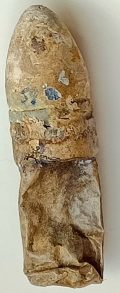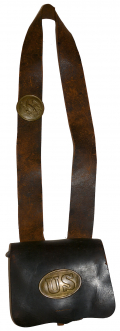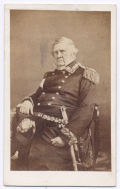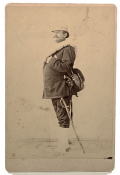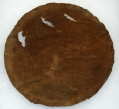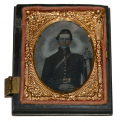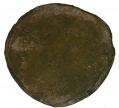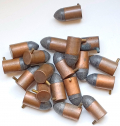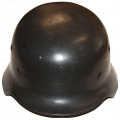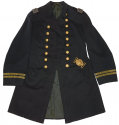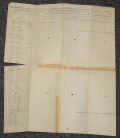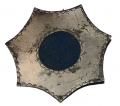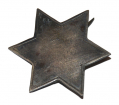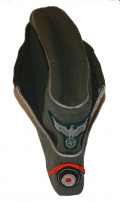site search
online catalog
Search Results
Showing results 1401 to 1450 out of 3131 for sold
PIECE OF PRIVATE PURCHASE SOLDIER’S HIGH RIBBED KNIT SHIRT FORT PEMBINA, NORTH DAKOTA
Excavations at Fort Pembina in anaerobic soil conditions have yielded a number of expected and rare finds giving a glimpse of the material culture of a small US army frontier post during the Indian… (1052-1111) Learn More »
SCARCE J. HENRY & SON “SABER RIFLE” PENNSYLVANIA MILITIA AND EARLY WAR VOLUNTEERS, ILLUSTRATED IN DRILL MANUALS
These scarce, attractive and rather unique looking .58 caliber rifles made by J. Henry & Son have 35-inch octagon-to-round browned barrels, long-range rear sights and brass mounts encompassing the… (1193-24) Learn More »
"DUG" .58 CALIBER RIFLE MUSKET CARTRIDGE BY JOHNSON & DOW
Johnson & Dow received patents #33,393, #34,061, and #35,687 dated October 1, 1861, January 7, and June 24, 1862 for their cartridges. Using paper or fabric that was treated to make it… (236-944) Learn More »
.35 CALIBER MAYNARD CARTRIDGE
Dr. Edward Maynard held patent #22,565 dated January 11, 1859. By this patent, cartridge cases for the Maynard carbine were made of drawn brass to form a tube with a closed end. A brass disk was… (236-942) Learn More »
EXCAVATED HILT FOR A M1850 FOOT OFFICER SWORD
This is the cast and chased brass counterguard and knucklebow from a regulation US 1850 pattern foot officer’s sword, the standard sword carried in the Civil War by infantry lieutenants and… (490-6773) Learn More »
PATTERN 1861 CARTIDGE BOX WITH SLING AND BOTH PLATES
Box is for carrying the .58 caliber cartridge. Outer flap is in excellent condition. The leather surface is very smooth and mostly clean with some minor edge wear. The remains of the broken latch tab… (2023-1367) Learn More »
$1,295.00
ON HOLD
CDV OF US NAVY VETERAN AND DOUBLE AMPUTEE BERNARD TOBY / TOBEY & SON – STANTON’S DISPATCH REGARDING VICTORY AT SECOND BATTLE OF FORT FISHER
Carte featuring uniformed sailor and double amputee Bernard Toby / Tobey (name spelled variously), with both arms missing below the elbow, having ribbons on his shirt and a strapped “hurdy-gurdy”,… (160-245) Learn More »
SEATED VIEW OF LIEUTENANT GENERAL WINFIELD SCOTT
Scott is posed seated and holding a bi-corn in his lap. He wears a dark double-breasted frock coat with brush epaulettes and matching dark trousers. The frock coat has embroidered oak leaf borders on… (160-376) Learn More »
IDENTIFIED BROOKS PATENT “WRITING, WORK AND TOILET CASE COMBINED,” OF SERGT. ENOCH JOY, 18th NEW HAMPSHIRE, WITH HIS PHOTOGRAPH: EX-TEXAS CIVIL WAR MUSEUM
This is an excellent example of a Civil War soldier’s writing kit, one of several different designs marketed to new soldiers directly and through loved ones who wished them to write. The Brooks… (1179-623) Learn More »
YORK COUNTY POWDER HORN
An elegant powder horn. From the size, a priming horn (approx 8" in length). Pleasing cream colored body shading to a greenish brown at the spout. The base is convex, lathe turned to produce incised… (480-354) Learn More »
EXCAVATED HILT FOR A M1850 FOOT OFFICER SWORD
This is an excavated brass counterguard and knucklebow from a regulation US 1850 pattern foot officer’s sword, the standard sword carried in the Civil War by infantry lieutenants and captains, as… (490-6775) Learn More »
ITALIAN PIEDMONTESE INFANTRY SHORT SWORD, FASCINE KNIFE
This is a good example of the short sword or side knife issued to foot troops in the mid to late 1800s for use in constructing fortifications and clearing undergrowth, but also as a potential last… (462-327) Learn More »
CABINET CARD PHOTO OF US NAVY SPANISH AMERICAN WAR OFFICER ATTIRED FOR CAMPAIGN SERVICE ON LAND- WILLIAM H. SCHUETZE- HE OPENED THE BATTLE OF SANTIAGO
This is a very nicely posed Spanish-American War period cabinet card photograph backmarked by a New York photographer showing a slightly portly US Navy officer dressed for service with a landing… (1219-46) Learn More »
KEPI CROWN FROM FORT PEMBINA, NORTH DAKOTA
This crown from a soldier’s kepi comes from excavations at Fort Pembina, ND, and shows three oval holes and one small slit, with some edge wear and stains. The color has shifted from blue to brown,… (1052-430) Learn More »
REMINGTON ZOUAVE BAYONET: “US MODEL 1862 CONTRACT RIFLE”
This is a good example of the brass-hilted sword/saber bayonet for the Remington Model 1862 US Contract Rifle, best known as the “Remington Zouave.” The blade is full length, with good edge and… (490-4297) Learn More »
CIVIL WAR SEWING KIT WITH REGIMENTAL BADGE
This small soldier’s sewing kit, popularly known as a “housewife” in Civil War camp jargon, is made of a red wool, with the edges bound in a light green, which might be a faded light blue, and… (1179-548) Learn More »
NINTH-PLATE TINYPE OF A SEATED FEDERAL SOLDIER IN A HALF UNION CASE
Clear tintype of a seated Union soldier posed with one hand resting in his lap and the other holding the hilt of an import sword placed beside him. He wears a dark artillery or cavalry shell jacket… (160-550) Learn More »
COLLECTION OF ITEMS BOTH WARTIME AND VETERAN IDENTIFIED TO 8TH IOWA INFANTRY OFFICER
This lot consists of item identified to Lieutenant Spencer Smith of Company A, 8th Iowa Infantry. Smith was born in Ogle County, Illinois on January 14, 1839 and relocated to Iowa with his family in… (460-1466) Learn More »
$995.00
Originally $1,100.00
TINY GETTYSBURG SOUVENIR FOLDING POCKET KNIFE BY ARROW CO.
Here we have an interesting miniature Gettysburg souvenir which appeals to knife collectors as well. This small metal pocket knife measures a mere 1.5 inches in length and is just over a quarter of an… (635-463) Learn More »
KEPI CROWN FROM FORT PEMBINA, NORTH DAKOTA
This crown from a soldier’s kepi comes from excavations at Fort Pembina, ND, and is in remarkably good condition, showing just one short tear, with no fabric missing, a good edge, and traces of blue… (1052-442) Learn More »
12MM PINFIRE CARTRIDGE BY CHARLES FUSNOT
These are cartridges for the Lefaucheux revolver. This is the “short” pinfire cartridge; with lead bullet seated into a copper case with a stout pin protruding from the bottom edge. This features… (M19951) Learn More »
UNCOMMON GERMAN LUFTWAFFE MODEL 1835 HELMET
Exceptional and uncommon Luftwaffe Model 1935 helmet made with only a single eagle decal and no national shield. The lack of a national shield (and it never had one) dates the helmet to mid-1940;… (2024-190) Learn More »
$1,800.00
ON HOLD
CIVIL WAR US NAVY LT. COMMANDER’S COAT AND BUCKLE OF ALEXANDER COLE RHIND - USS CONSTELLATION, USS CRUSADER, USS KEOKUK, FOUGHT CS BATTERIES AT DEEP BOTTOM, COMMANDED A “POWDER BOAT” AGAINST FT. FISHER, LATER REAR ADMIRAL
This is a very appealing regulation Civil War navy officer’s frock coat with interesting history. The coat is very dark blue, almost black, double-breasted with two rows of 9 US Navy officer’s… (1179-650) Learn More »
SEATED VIEW OF MAJOR GENERAL ALFRED TORBERT – BY BRADY
Image is of Torbert from the waist-up. He wears a dark double-breasted frock coat with black felt collar and cuffs and major-general’s shoulder straps. Contrast and clarity are excellent as are the… (160-398) Learn More »
PENNSYLVANIA CAPTAIN’S COMMISSION FOR ELI DAUGHTERY - CO. K, 210TH PENNSYLVANIA INFANTRY
Dated Harrisburg, PA, 7 November 1864. Pre-printed state commission document, 16” x 13, w/ state seal, signed by Eli Slifer, Secretary of the Commonwealth. Double matted in gray & black,… (2024-221) Learn More »
$275.00
ON HOLD
INDIAN WAR SOLDIER’S SOCK FROM FORT PEMBINA, ND
This comes from the excavations at Fort Pembina, ND, and appears to be the 1877 pattern army sock, which was medium gray in color, had white toes, and the weave of the heel running parallel with the… (1052-592) Learn More »
CIVIL WAR - INDIAN WAR SOCK FROM FORT PEMBINA, ND
This comes from the excavations at Fort Pembina, ND, a fort established in 1870 and in operation into the 1890s. The dig was conducted on private property with the owner’s permission and has yielded… (1052-581) Learn More »
CIVIL WAR UNIFORM DRESS COAT LAPEL FROM FORT PEMBINA
These section of lapel and coat lining from a Civil War US army dress coat was discarded by a soldier at Fort Pembina, ND, where it was recently recovered from excavations in wet, anaerobic soil that… (1052-567) Learn More »
PIECE OF ARMY BLANKET FROM FORT PEMBINA, NORTH DAKOTA
This piece of a U.S. Army blanket comes from the excavations at Fort Pembina, ND, where wet, anaerobic soil conditions produced not only leather gear, but cloth in amazingly good condition. This shows… (1052-607) Learn More »
SCARCE CIVIL WAR PONCHO OR “GUM BLANKET” FRAGMENT
Civil War period ponchos and rubber blankets are extremely scarce despite being widely used and valued by troops in the field. They were so useful at home as to be used up by veterans and their… (1052-628) Learn More »
MUSTER ROLL OF CAPTAIN SPEAR’S COMPANY, 23RD PENNSYLVANIA INFANTRY (3 MONTH REGIMENT)
Standard Government muster roll, 33” x 20. Lists 64 names. Signed Captain Hiram K. Spears, June 30th 1861, Camp near Downsville, MD. Exhibits wear and chipping near extremities. Old tape repairs… (1154-32) Learn More »
FULL LENGTH SEATED CDV OF GENERAL BEN BUTLER
Image shows Butler seated in a chair facing slightly to the right. He wears a dark double-breasted frock coat with major general’s shoulder straps with a string of oak leaves on each side of his… (160-248) Learn More »
WAIST-UP SEATED VIEW OF US NAVY MASTER JAMES OGILIVE
CDV shows Ogilvie seated at a table in the classic Napoleonic pose with one hand tucked in his coat. He wears a dark double-breasted frock coat with the shoulder straps of a Master. He also wears a… (160-488) Learn More »
SECOND EDITION STUDY OF THE MINE RUN CAMPAIGN
This title was part of The Virginia Civil War Battles and Leaders Series produced by H. E. Howard during the 1980’s and ‘90’s. The full title of this volume is “MINE RUN: A CAMPAIGN OF LOST… (1180-169) Learn More »
HANCOCK’S VETERAN CORPS BADGE
Sometimes confused with the Veteran Reserve Corps, or the earlier First Army Corps in the Army of the Potomac, Hancock’s Veteran Corps (sometimes referred to as Hancock’s First Veteran Corps) was… (1179-640) Learn More »
EIGHTH CORPS BADGE
Use of this badge is complicated by confusion between the 8th Corps, which technically was under Lew Wallace and guarded the B&O Railroad in 1864 and George Crook’s “Army of West Virginia,”… (1179-637) Learn More »
CDV LITHOGRAPH OF MONUMENT TO THE 77TH NEW YORK INFANTRY
Image shows the monument to the 77th New York Volunteer Infantry which stands in Congress Park in Saratoga Springs, New York. It was erected in 1875 by veterans of the regiment. Paper has some light… (160-327) Learn More »
VIEW OF SHELL DAMAGE ABOARD THE CONFEDERATE SHIP CSS TEASER – IMAGE #483 OF “BRADY’S ALBUM GALLERY”
Image shows part of the deck of the CSS TEASER. Visible in the foreground is a large hole with broken timbers caused by a shell. In the background one can see further up the deck past part of the… (160-371) Learn More »
AUTOGRAPHED FIRST EDITION COPY OF THE HISTORY OF THE 26TH GEORGIA INFANTRY
Title page reads “SOUTH GEORGIA REBELS: THE TRUE WARTIME EXPERIENCES OF THE 26TH GEORGIA VOLUNTEER INFANTRY. LAWTON – GORDON – EVANS BRIGADE, CONFEDERATE STATES ARMY 1861-1865” by Alton J.… (1180-178) Learn More »
SCARCE CIVIL WAR INDIA RUBBER BLANKET OR PONCHO FRAGMENT
Excavated portion of a Civil War poncho or rubber blanket. This is a rough rectangle, preserving one edge with its binding intact and one of the brass grommets, with its diamond/square shaped… (1052-570) Learn More »
SCARCE CIVIL WAR INDIA RUBBER BLANKET OR PONCHO FRAGMENT
Excavated portion of a Civil War poncho or rubber blanket. This comes from the excavations at Fort Pembina in North Dakota, an army post garrisoned from 1870 to 1895. They were supplied at first with… (1052-568) Learn More »
RARE GERMAN ARMY MODEL 1938 OFFICER PANZER RECONNAISSANCE FIELD CAP
Exceptional German overseas field cap with rare copper-brown piping denoting elite panzer reconnaissance (Panzer-Aufklärungs) troops. This is a private purchase example of very high quality. The… (2024-189) Learn More »
.442 WESTLEY RICHARDS “MONKEY TAIL” CARTRIDGE
This specimen is a very nice regulation paper wrapped skin cartridge for the British “Monkey Tail” rifles. This one is wrapped in tan paper. Cloth tear strip sticking out of the bottom end. Very… (1212-40) Learn More »
.442 WESTLEY RICHARDS “MONKEY TAIL” CARTRIDGE – BLUE PAPER
This specimen is a very nice paper wrapped skin cartridge for the British “Monkey Tail” rifles. This one is unusual as it is wrapped in blue paper (typically tan paper). Cloth tear strip sticking… (1212-54) Learn More »
EARLY GETTYSBURG SOUVENIR WOOD POSTCARD ALBUM
Gettysburg early souvenir wood postcard album. Measures 4 1/2" x 6 1/2" x 1 1/4". Cover stamped “Pickett’s Charge/July 1, 2, 3 1863/Gettysburg”, back cover stamped “Wheatfield”. “Devil’s… (635-588) Learn More »
REPRODUCTION .44 REMINGTON BY PIETTA WITH SPARE CYLINDER
Revolver has an 8.00 inch octagon barrel and a six-shot cylinder. Barrel, loading lever, cylinder and frame are all finished bright. All nipples are present on the cylinder. Hammer is also bright.… (922-30) Learn More »
CIVIL WAR FROCK COAT LAPEL FROM FORT PEMBINA, ND
This lapel comes from the left side of US army dress coat discarded by a soldier at Fort Pembina, ND, and was excavated in wet, anaerobic soil that has preserved leather and cloth in remarkable… (1052-588) Learn More »
PIECE OF PRIVATE PURCHASE SOLDIER’S SHIRT FORT PEMBINA, NORTH DAKOTA
Army issue shirts had little going for them in comfort and less in style. This is a fragment of a privately purchased shirt from the excavations at Fort Pembina, ND, garrisoned from 1870 to 1895. This… (1052-606) Learn More »
CARVED WOOD FROM FORT PEMBINA
At least one other similarly shaped piece of wood has come from the excavations at Fort Pembina, near the Red River in North Dakota. At first sight we guessed it was a wood arrow carved as for use as… (1052-637) Learn More »
CARVED WOOD FROM FORT PEMBINA
Excavated at Fort Pembina, near the Red River in North Dakota, this tapered wood cylinder is most likely a buoy or float from a fishing net, having grooves cut at either end for tying in place. Army… (1052-636) Learn More »
Showing 1401 to 1450 out of 3131
Most Popular
Historical Firearms Stolen From The National Civil War Museum In Harrisburg, Pa »
Theft From Gravesite Of Gen. John Reynolds »
Selection Of Unframed Prints By Don Troiani »
Fine Condition Brass Infantry Bugle Insignia »
British Imported, Confederate Used Bayonet »
Scarce New Model 1865 Sharps Still In Percussion Near Factory New »
featured item
“I LIKE YOUR STYLE” THE REGIMENTAL STANDARD OF THE 12th ILLINOIS CAVALRY: GAMBLE’S BRIGADE UNDER BUFORD ON JULY 1 AT GETTYSBURG
We can’t think of a more flamboyant, devil-may-care motto on a cavalry standard than this one, whose overtly casual nature no doubt intentionally contrasts with their combat and fighting record. Placed in quotation marks, this was taken from the… (1179-033). Learn More »
site search
Upcoming Events
May 16 - 18: N-SSA Spring Nationals, Fort Shenandoah, Winchester, VA Learn More »





